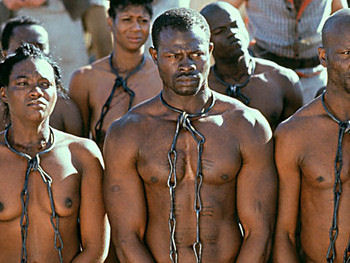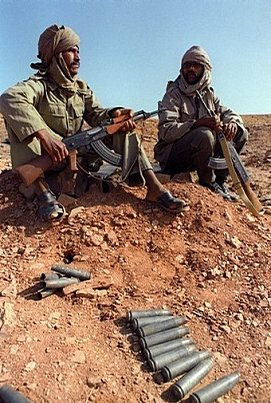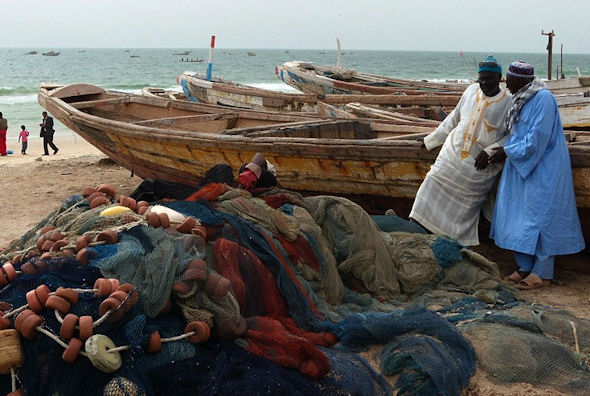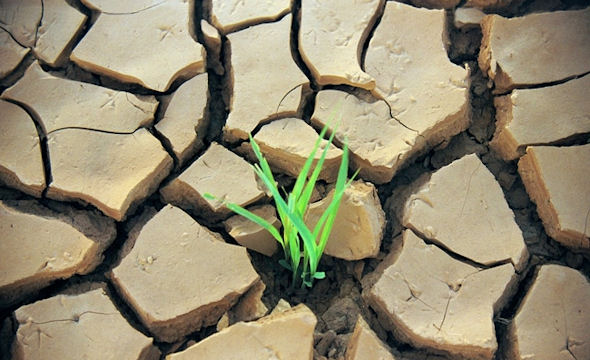|
Size: 1.030.700 km2 (4x the United Kingdom).
Capital: Nouakchott.
Number of inhabitants: 3.13 million.
Number of inhabitants per km2: 3.1.
Largest religious groups: Nearly the entire population is Islamic.
Official language: Arabic. French, Pulaar, Wolof, Sominke and Hassaniuya are also spoken.
Largest populations: 30% of the population is Moorish, i.e. of mixed Berber and Arabic origin. 30% of the population is black. The remaining part is of mixed Moorish and black origin.
Neighbouring countries: Western Sahara (claimed by Morocco), Senegal, Mali and Algeria.
National holiday: Independence day on 28 November.
|
 |

Climate: desert climate, warm throughout the year. Especially in March and April sand and dust storms occur. In this period the sirocco frequently blows from the Sahara. The country also regularly suffers from long-term droughts.
Type of state: republic. A government consisting of soldiers led by Mohammed Ould Abdel Aziz governs the country. In Mauritania everyone of 18 years and older has the right to vote.

History
Around 700 the kingdom of Ghana arose in the current Senegal, Mauritania and Mali. It became an important transfer point for the trade of the South to the North. Especially gold and ivory found their way to countries in North Africa through the kingdom. At the end of the 11th century Islamic fighters from Morocco invaded the kingdom and conquered it. Thus Islam entered Mauritania.

Afterwards the kingdom of the Malinké people arose. Mali, a neighbouring country of Mauritania, was named after this people. A part of Mauritania became part of this kingdom, the remaining part of another kingdom, that of the Songhai. After that the North was governed by emirs who brought the Arabic language to the country.
In the 17th century the tribes of the Maghfras established a state in Mauritania. Afterwards the North remained in the hands of emirs whereas the remaining part of the country became part of other Islamic kingdoms, such as the Oualo and the Fouta-Toro. These kingdoms were frequently at war with the emirates in the North.
In 1902, France got control over Mauritania, even though the emirates in the North continued to resist the French for years. The country became part of the French colony French West-Africa. As from 1946 it was not a real colony anymore, but it remained under French sovereignty.

Ten years later it got a certain autonomy. In 1958, the domestic governors of the country called out the Islamic Republic of Mauritania and on 28 November 1860 the country became entirely independent.
The history of Mauritania after 1960 is dominated by three matters:
- Tensions between people of Moor and of black origin: The Moors more or less governed the country, the blacks felt discriminated and they actually were. An example: up to 1981 slavery existed where black slaves served the Moors. This ethnic antagonism has its roots in the period in which the emirates in the north frequently fought against kingdoms in the south.
 The Western-Sahara issue: this area is situated between Mauritania and Morocco. It used to be a Spanish colony. In 1974 the Spaniards withdrew from this area. Morocco considered the former colony as part of its territory and still does. Mauritania claimed this area as well. The Western-Sahara issue: this area is situated between Mauritania and Morocco. It used to be a Spanish colony. In 1974 the Spaniards withdrew from this area. Morocco considered the former colony as part of its territory and still does. Mauritania claimed this area as well.
Morocco conquered the greatest part of this area and Mauritania conquered the remaining part. Then the rebel movement Polisario started waging war against the Moroccan and Mauritanian governors of the area. This movement was supported by Algeria. The costs of warfare got so high for Mauritania that the economy of the country greatly suffered from it.
Because of this Mauritania withdrew from Western Sahara in 1979. After that the Polisario fought against the Moroccan governors of this area. In 1991 the movement declared an armistice with the Moroccan government. The United Nations then determined that the people of the area could hold a referendum to decide whether they wanted to merge with Morocco or be independent. However, this voting still has not taken place. Western-Sahara does have its own government now, which has been recognized by dozens of countries.
Polisario warriors
- An unstable country government: Mauritania has experienced various military coups. The first one took place in 1978. The junta, which seized power then, made peace with the Polisario and withdrew the Mauritanian troups from Western Sahara.
In 1984 a high-ranked officer, named Maaoya Ould Sid Achmed Taya committed a coup and subsequently governed the country with an iron hand until he was cordoned off himself in 2005. The new rulers inplemented democratic reforms.
A year later a military junta cordoned this government. Then general Sidi Mohammed Ould Abdel Aziz became president of the country.
Production and trade
Mauritania is a member of the African Union, a counterpart of the European Union.
Besides it is a member of several other organizations that are related to production, agriculture and international trade:
- Food and Agriculture Organisation (United Nations)
- International Monetary Fund
- UNCTAD
- World Trade Organisation WTO
ECOWAS will represent Mauritania during its negotiations with the European Union.
Mauritania particularly imports and exports goods from France (an EU country), China, Spain (an EU country), the United States and Belgium (an EU country). The most important import products are machines, tools, oil products and food products.
The country particularly exports goods to China, France (an EU country), Italy (an EU country), Spain (an EU country) and Japan. It especially concerns iron ore, fish and fishery products, gold and copper.

frozen makrel for the export
Struggle against poverty
The soil contains iron ore, gypson, gold, copper, diamonds and phosphate. It is assumed that oil can be found under the sea bed in front of the coastline, but even after thorough research on the spot no large oil fields were found. In front of the coastline rich fishing banks are situated, because cold water with a great many nutrients wells up there from the deep sea. These fishing areas are among the richest of the world.
In spite of this, Mauritania is a poor country. This is partly caused by the drought that causes great damage to agriculture and the weak economic policy of the government.
Apart from that, foreign fishing companies are present in the coastal waters near Mauritania with their large, state-of-the-art equipped ships, which catch large quantities of fish. As a result there us not much fish left to catch for the fishermen from the country itself. Because of this and because their boats are smaller and are not equipped with the most modern tools, they do not earn much from fishing.

Mauritania was burdened by continually growing foreign debts. That is why the government decided to join the international Heavily Indebted Poor Countries project in 2000. This became a great success; after some time the debts were almost entirely acquitted. Fighting poverty became an important point on the agenda for the government and the country received aid from the IMF and the World Bank in doing so.
In order to achieve this the country started a three year program with the IMF and the World Bank, Poverty Reduction and Growth Facility, or, in short, PRGF. As the name indicates, not only fighting poverty was an aim, but also stimulating the economy. The PRGF program was a great success, until Mohammed Ould Abdel Aziz seized power after a coup. Then the IMF and the World Bank withdrew their contributions to this program.
Agriculture and fishing
Because of the dry climate and lack of fresh water resulting from it, agriculture is hardly possible. The most important source of fresh water is the Senegal river, that runs through the South of the country. Extensive livestock farming is seen more often. Large pieces of land are grown with grass and low bushes, where animals can graze. There, nomads roam with their cows and sheep.

Nomads tents
Half of the labour force is involved in arable farming or livestock farming. The most important agricultural products are dates (homegrown), rice (homegrown), grain and millet (homegrown). Crops and vegetation in areas where cattle can graze are regularly devoured by enormous swarms of desert grasshoppers, which leads to a decrease in the food provision for people and cattle. Then there is famine and increasing poverty.

Arable farming and livestock farming often face long term drought. This occurred for example in 1978. For this reason, during the 70s and 80s a great many farmers and livestock farmers moved to Nouakchott and other towns to find work there.
On the other hand fishery provides a lot of food and currencies. Near Nouakchott a harbour was constructed in 1986 where vessels, especially large fishing vessels, can moor.
|








 The Western-Sahara issue: this area is situated between Mauritania and Morocco. It used to be a Spanish colony. In 1974 the Spaniards withdrew from this area. Morocco considered the former colony as part of its territory and still does. Mauritania claimed this area as well.
The Western-Sahara issue: this area is situated between Mauritania and Morocco. It used to be a Spanish colony. In 1974 the Spaniards withdrew from this area. Morocco considered the former colony as part of its territory and still does. Mauritania claimed this area as well.






